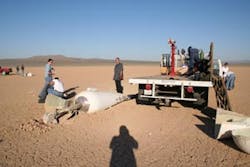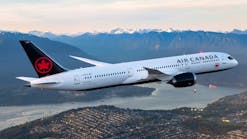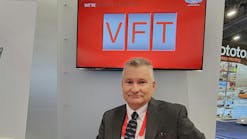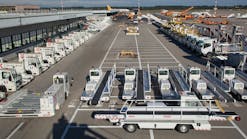When Scaled Composites, LLC, was hired to test a new aerial launch program, they needed to develop an efficient method to clean up the material they dropped over the dry lakebed where they were conducting the tests. As part of their arrangement with the park area people who use the area must return the environment to its natural state. Using a davit crane generally used as a floor-mounted piece of equipment, the ground crew at Scaled was able to modify their flatbed truck and the crane's base, which made hoisting the payload debris onto the truck for removal much more efficient.
Located 80 miles north of Los Angeles, in Mojave, Calif., Scaled Composites is one of the world leaders in innovative aerospace design and technology. Specializing in air vehicle design, tooling, manufacturing, composite structure design, analysis and fabrication, Scaled's main area of focus lies in research and development of composites. A large part of the work they do is currently geared toward developing new manufacturing techniques that will be vital to future aerospace success. In addition, new materials and processes are being tested on a regular basis, including the recent aerial launch project.
The project consisted of releasing a "mock" rocket at an altitude of 10,000 feet, simulating the launch of a space rocket from an aircraft. The aerial launch project was performed to collect data on finding the proper pitch for successful launches into space. In theory, the rocket would fire after the aircraft had released it and peeled off to one side. The premise being that an air launch system uses less fuel and positions the rocket in alignment with its final orbit. Less fuel means that a launch costs less money, is more efficient, and can lead to more frequent missions to space.
Creative and functioning design is what Scaled does best and that translates to all of their departments including the ground support crew. "Everybody who works here wears so many different hats," says Robert Storch, ground support mechanic at Scaled. "We all have our day-to-day tasks, but as a company that is constantly looking to advance technology, we often find ourselves exploring new and better ways to do things."
A normal day for Storch and his ground crew consists of maintaining the 10 vehicles used for ground support. This means regular oil changes, checking for cracks and faulty hardware on the aircraft and making sure all the start carts are operational (start carts are equipped with generators and are used to power-up the aircraft as opposed to running up the engines). However, when Scaled is hired to run special projects and perform flight tests, this day-to-day maintenance work turns into project preparation and execution for the ground support team.
For the air launch system being tested, the ground crew needed to develop an efficient way to clean up heavy debris dropped from the aircraft onto the Mojave lakebed. The debris in fact is the payload attached to the aircraft being tested. And, weighing roughly 2,000 pounds, it’s not a task that can be accomplished without some sort of equipment. In order to make their job easier for the project, the ground crew used a flatbed truck, a davit crane manufactured by Thern Inc., and developed a modified base that could easily hoist the 2,000-pound material onto the back of the truck without causing any structural damage to the vehicle. "The crane worked well for the lifting application we needed for this project," Storch says. "We did have to make some modifications at the beginning because the davit is in fact manufactured as a plant floor crane instead of a truck-mounted crane."
In order to stabilize the crane during lifts the crew had to widen the base to keep it from damaging the truck. Using 5/8-inch thick steel plate mounted on the top of the flatbed just under the base of the davit, the crew was able to increase the area of the base. Underneath the flatbed, the crew mounted reinforced 1/4-inch angel iron and 3/8-inch channel iron to reinforce the underside of the bed. After the new base was attached, mechanics then brought the torque of all bolts to Thern's listed specifications of 150 feet/pound. With a reinforced flatbed and wider base, the truck was outfitted to handle the heavy payloads without bottoming out.
With a ground support crew ready to go it was time for flight-testing to begin. Scaled launched their Proteus twin turbofan high altitude multi-mission aircraft. Powered by Williams International FJ44-2E engines, the craft is designed specifically to carry payloads in the 2,000 pound class to altitudes above 60,000 feet and remain on station up to 14 hours.
For the test, the pilot brought the Proteus aircraft equipped with its load up to 10,000 feet and dropped the payload while measuring how it pitched. For collecting this data, Scaled used a comprehensive data acquisition tool that included real-time air-to-ground telemetry. Data was then displayed to both the ground crew or to pilots in the air in order to make adjustments. Onboard computer systems, recorders and transducers used in conjunction with ground-based equipment made gathering data for the flight extremely efficient. Once data was collected, Scaled engineers were able to create reports on what the pitch needed to be for a successful launch.
The payload or "mock" rocket Proteus carried for the test was fabricated from two propane tanks welded together and measured to weigh exactly 2,000 pounds. "When a 2,000 pound payload is dropped from 10,000 feet, there is going to be some clean-up," Storch says. "And cleaning up 2,000 pounds of metal is no easy task."
On the ground Storch and his crew with the modified Thern davit were ready to pick up as much of the payload as possible. "When we went to pick up the first of the material we were worried that our truck wouldn’t be able to handle the debris because of the weight," Storch says. "We were really impressed when it held together and we were able to easily hoist the material quickly into the truck."
"Even though it was successful at first we noticed that the truck looked like it wanted to turn over," Storch says. "But the crane held strong and once the suspension hit on the stop blocks we hoisted the material easily onto the bed of the truck." The team easily lifted the equipment and debris straight up and over for loading, clearing the area of any material dropped during the test.
"It’s not just the testing we are concerned about," Storch says. "We also want to maintain the integrity of the environment of the Mojave." In fact, the Mojave region where Scaled Composites does a majority of their testing is known for its fair, year-round weather and as a spot sought out not only by aerospace testing companies but by film studios as well.





